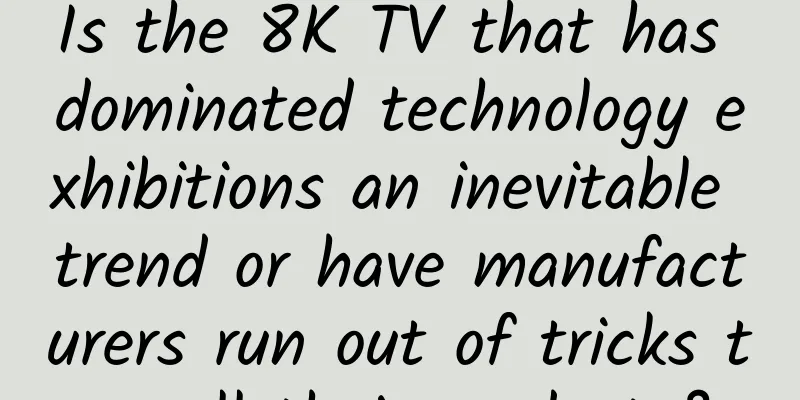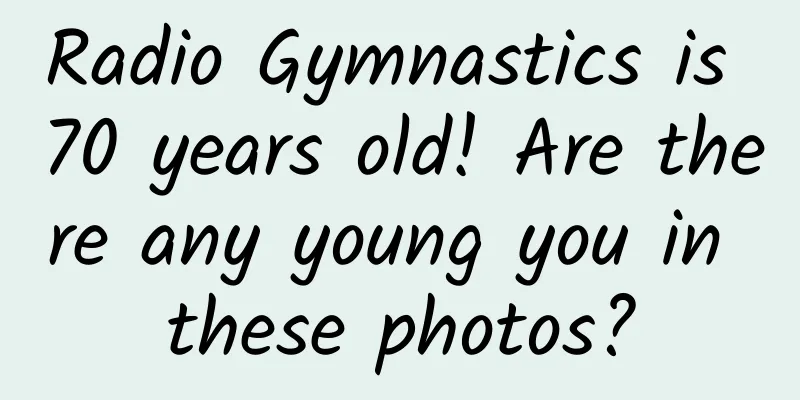Is the 8K TV that has dominated technology exhibitions an inevitable trend or have manufacturers run out of tricks to sell their products?

|
Different from the focus of most young consumers today, "mobile phones play a supporting role and home appliances play the leading role" is becoming a new situation emerging at CES, the largest technology exhibition. As the most eye-catching category of home appliances, televisions have naturally become the absolute star at today's technology exhibitions. When domestic TV manufacturers have almost exhausted the concept of "Internet TV", 8K, which represents the trend of display technology, has occupied the commanding heights of the booths of major international TV manufacturers. This has caused many users to sigh: 4K TVs have just been placed in the living room, and 8K TVs are about to come, so should they buy them? 16 times clearer than 1080P, you should pay more attention to practicality before talking about the price A TV that can be classified as 8K means that its screen has a resolution of an astonishing 7680×4320 at a 16:9 ratio. This value is 16 times that of traditional full HD 1080P and 4 times the 4K resolution commonly seen in the TV industry. However, as Sharp gave when it released a 70-inch 8K TV in the second half of 2017, even for a 70-inch screen that is difficult to fit in most ordinary family living rooms, the 8K resolution must be within a 1-meter viewing distance to show its ultra-high fineness advantage. But are you really willing to be less than 1 meter away from the screen when watching a 70-inch TV? This seems to be just like Sony's insistence on bringing 5.5-inch 4K screens to smartphones. In the face of the reality that 400PPI is considered "retina" level, Sony is the only manufacturer that currently makes 4K screen phones and the result of achieving 800PPI. Of course, the bigger practical problem facing 8K TVs is that the content quality is simply unable to keep up with the surge in screen resolution. Judging from the more professional BD Blu-ray disc market in the private sector, true 4K UHD Blu-ray discs have just shown signs of development. According to incomplete statistics, there were less than ten officially released genuine UHD Blu-ray movie discs in China before 2018. In the eyes of film and television enthusiasts, 8K is currently a castle in the air. Most smart TV users today prefer to watch online video content directly online. In addition to the fact that most domestic video websites like to use "standard definition" and "ultra-high definition" to vaguely define video clarity, the so-called "online 4K" video resources also mostly use the 1080P difference method. This does not seem to be a big problem on 4K TVs, but makes 8K TVs seem unnecessary. TV manufacturers were obviously aware of this problem before launching 8K products. For example, Samsung launched 8K artificial intelligence technology for its 85-inch 8K QLED product at this year's CES, emphasizing that AI can be used to speed up image processing by 64 times and automatically upgrade low-resolution images to 8K quality. At the same time, more TV manufacturers regard the 2020 Tokyo Olympics, which will adopt 8K live broadcast, as a turning point to stimulate the market. But from a certain perspective, in fact, the 8K live broadcast of the 2020 Olympics may just be one of the footholds for Japan to show its high-tech technology. After TV manufacturers magnify and interpret it, unless users really find the motivation to switch to 8K TVs to watch sports games, so that they are willing to only watch the 8K Olympics for a few years, otherwise, 2K, 4K and some pseudo-8K content will still be frequent visitors on 8K TV screens. Considering the relatively high market positioning of 8K TVs in the short term, their prices are even several times higher than those of 4K TVs of the same size. This is like you have spent all your life's financial resources to buy the Lamborghini sports car of your dreams, but unfortunately in the city where you live, you can't find a road where you dare to step on the accelerator to the bottom. Sony is not optimistic about 8K TV in the short term, and the originator of 8K is also busy producing OLED Coincidentally, not only some rational TV consumers, but even TV manufacturers that have launched 8K products have expressed a view that they are not blindly optimistic about the market prospects of 8K TVs. Among them, Ichiro Takagi, senior executive vice president of Sony Corporation and president of Sony Visual Products, believes that Sony has a clear product strategy for 8K TVs, and that achieving 8K resolution is not a very difficult technology, but the main problem at present is that there is no real 8K program content to match it. If consumers now buy 8K TVs at high prices but cannot get the picture quality that matches it, this is a situation that manufacturers do not want to see. You know, among the major high-end TV manufacturers in the world, Sony is one of the very few manufacturers that is also involved in the upstream fields of display technology and content manufacturing such as image recording equipment manufacturing and film and television manufacturing. Ichiro Takagi's remarks may also be intended to indicate that 8K has not been filmed yet, let alone played on TV. He also revealed that Sony's work focus in 2018 will still be the research and development of image processing technology and the promotion of OLED products. Coincidentally, Sharp, the "father of LCD" regarded by many industry insiders as the originator of 8K, seems to be shifting its focus to other directions after hastily launching consumer-grade 8K TVs last year. In mid-January, Sharp President and CEO Tai Jeng-wu announced that Sharp will start mass production of OLED panels as early as the first quarter of this year, thus breaking the current monopoly of Korean panel manufacturers. The company also plans to launch smartphones equipped with its own OLED panels in June or July this year. 8K may just be another "over-demand" to get you to buy a new TV In the face of ever-advancing technology, no one should deny the role of increased screen resolution in promoting the development of television. However, just as the significance of resolutions above 2K is no longer obvious for small-screen smartphones below 6 inches, large-screen TVs are also facing the problem of "is there any point in continuing to increase" in the face of 8K. A more reasonable explanation for the collective phenomenon of TV manufacturers playing the 8K trump card may be that in the face of the reality that the market growth trend of the entire TV industry is slowing down, the frequency of user upgrades is low, but the sales bottleneck needs to be broken, TV manufacturers are very happy to find "new user needs" for consumers from their own perspective. This even reminds me of the rise of smart TVs, when many users questioned TV companies for putting mobile phone processors and operating systems into TVs: If I want to make my TV smart, wouldn’t it be better to just spend a few hundred bucks and buy a box that is more convenient to upgrade? Why do many TV brands insist on pushing a large number of video websites and membership services on me on the TV screen even though the screen display effect is not good enough? Unfortunately, there are still many TV brands on the market that have poor screen display effects, but you can hardly buy non-smart TVs. As a winner of Toutiao's Qingyun Plan and Baijiahao's Bai+ Plan, the 2019 Baidu Digital Author of the Year, the Baijiahao's Most Popular Author in the Technology Field, the 2019 Sogou Technology and Culture Author, and the 2021 Baijiahao Quarterly Influential Creator, he has won many awards, including the 2013 Sohu Best Industry Media Person, the 2015 China New Media Entrepreneurship Competition Beijing Third Place, the 2015 Guangmang Experience Award, the 2015 China New Media Entrepreneurship Competition Finals Third Place, and the 2018 Baidu Dynamic Annual Powerful Celebrity. |
Recommend
Build a "Digital Great Wall" for the thousands of miles of border and coastal defense
Each "informationized sentinel" can det...
There are many types of disinfectants. Have you chosen the right one?
With the progress of science and technology, huma...
Popular Science Illustrations | Looking back at a hundred years of geophysical exploration
Modern oil exploration began in the mid-19th cent...
Interpreting ASP.NET 5 & MVC6 Series (16): Customizing View View File Search Logic
In MVC5 and previous versions, if we want to cont...
Amazon and Bezos are in great glory, but they are embarrassed in China
Amazon CEO Bezos has been all over the news on CN...
When people in their 50s or 60s go to the hospital for a physical examination, what items should they focus on?
More and more people are paying attention to thei...
Apple will release Swift 3.0 and announce the development content of the fourth version
Although the official version of Swift 3.0 will b...
Xiaomi's 46 high-definition posters tell you how to do fan marketing
How did Xiaomi achieve rapid development in just ...
What did the Internet giants say at the Boao Forum?
[[130720]] From March 26 to March 29, the 2015 Bo...
The most effective user growth methodology!
Isn’t the value of the product what makes users b...
In addition to volcanoes and strong men, Tonga also has these things you have never seen
Before this volcanic eruption, most people's ...
Good development habits, I have a few suggestions
This article does not introduce how to optimize t...
The details that make or break things: the little-known highlights from Google I/O 2015
Google I/O 2015 will be held at Moscone Center We...
How many steps are there in the "wandering moon" plan? Yutu wrapped tightly in a small blanket on the moon...
Yesterday was the Lantern Festival on the 15th da...
Chen Kai stock intraday T+0 trading system
Chen Kai stock intraday T+0 trading system resour...









